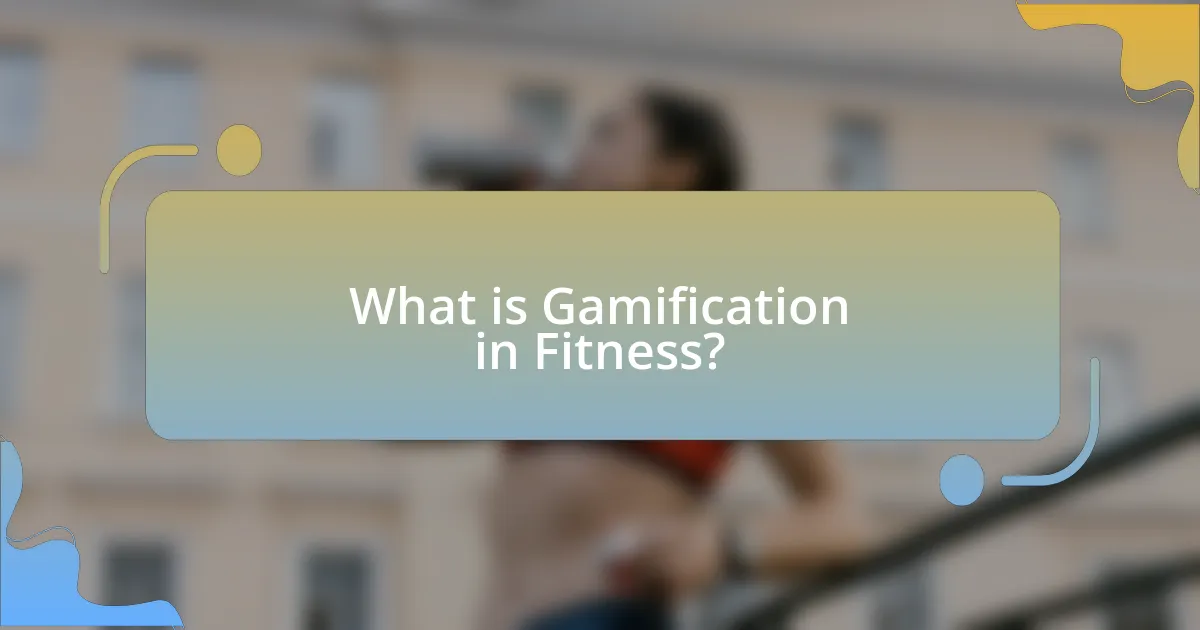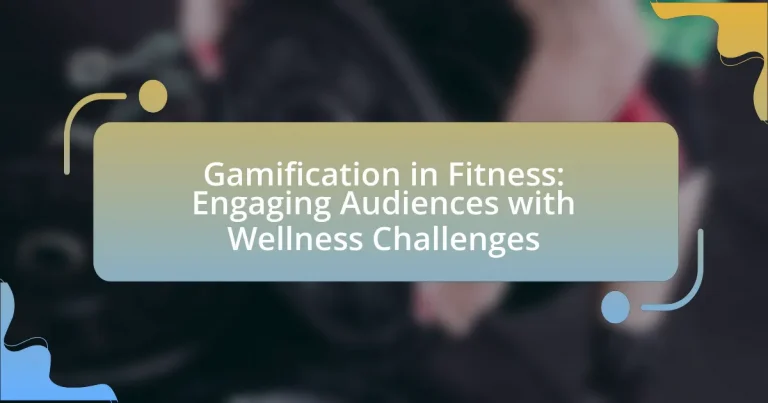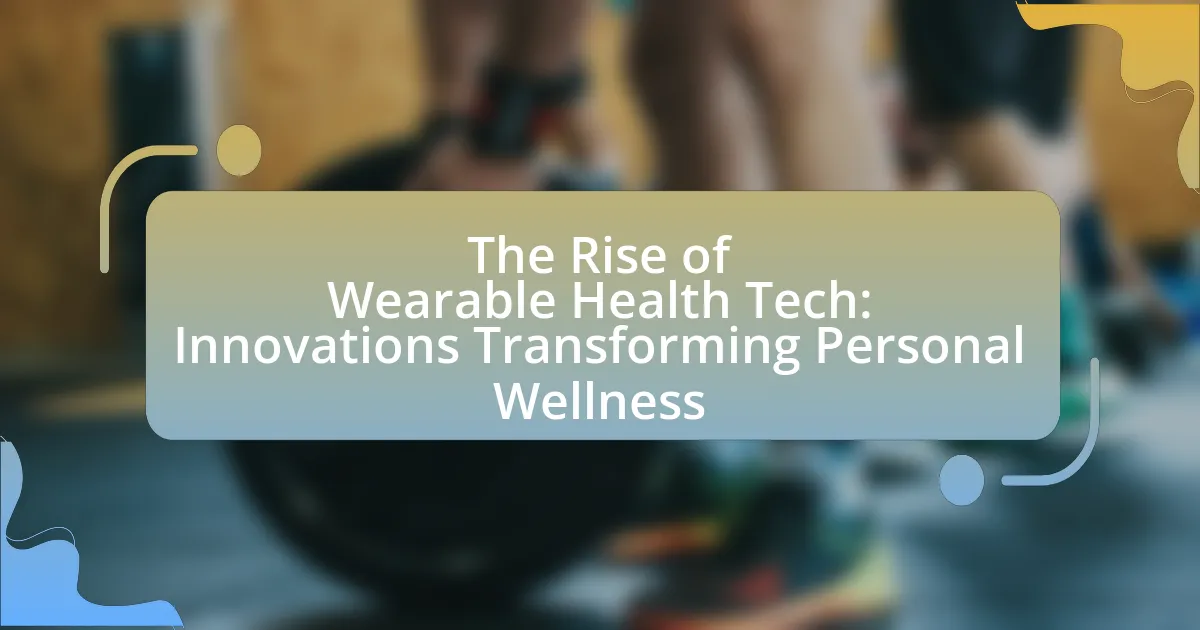Gamification in fitness involves integrating game design elements into non-game contexts to boost user engagement and motivation in physical activities. This article explores how gamification enhances fitness experiences through features like points, leaderboards, and challenges, leading to increased participation and adherence to exercise routines. Key elements such as goal setting, rewards, competition, and social interaction are examined, highlighting their impact on user engagement and motivation. Additionally, the article discusses the importance of inclusivity, effective rewards, and best practices for designing wellness challenges, while also addressing common pitfalls to avoid in fitness gamification.

What is Gamification in Fitness?
Gamification in fitness refers to the application of game design elements in non-game contexts to enhance user engagement and motivation in physical activities. This approach often includes features such as points, leaderboards, challenges, and rewards, which encourage individuals to participate in fitness routines and achieve their health goals. Research indicates that gamification can lead to increased physical activity levels, with a study published in the Journal of Medical Internet Research showing that participants using gamified fitness apps reported higher levels of motivation and adherence to exercise programs compared to those using traditional methods.
How does gamification enhance fitness experiences?
Gamification enhances fitness experiences by increasing motivation and engagement through game-like elements such as rewards, challenges, and competition. These elements encourage users to participate more actively in their fitness routines, leading to improved adherence and performance. Research shows that incorporating gamification in fitness apps can lead to a 30% increase in user engagement and a 25% improvement in workout frequency, as users are more likely to stick with their fitness goals when they are presented in a fun and interactive manner.
What are the key elements of gamification in fitness?
The key elements of gamification in fitness include goal setting, rewards, competition, and social interaction. Goal setting provides clear objectives for participants, enhancing motivation and focus. Rewards, such as points, badges, or tangible prizes, incentivize progress and achievement, reinforcing positive behaviors. Competition fosters engagement by allowing individuals to compare their performance against others, creating a sense of urgency and excitement. Social interaction, facilitated through community features or group challenges, enhances accountability and support among participants, leading to increased adherence to fitness routines. These elements collectively enhance user experience and promote sustained engagement in fitness activities.
How do these elements contribute to user engagement?
Gamification elements, such as points, badges, and leaderboards, significantly enhance user engagement by providing clear goals and immediate feedback. These elements motivate users to participate actively in fitness challenges, as they create a sense of achievement and competition. For instance, a study published in the Journal of Medical Internet Research found that gamified fitness applications increased user activity levels by 27% compared to non-gamified versions. This increase in engagement is attributed to the psychological rewards associated with completing tasks and competing with peers, which fosters a community atmosphere and encourages continued participation.
Why is gamification important for fitness audiences?
Gamification is important for fitness audiences because it enhances engagement and motivation through game-like elements. By incorporating challenges, rewards, and competition, fitness programs can increase user participation and adherence. Research shows that gamified fitness applications lead to a 30% increase in user activity levels compared to non-gamified counterparts, demonstrating that these elements effectively drive behavior change and improve fitness outcomes.
What psychological principles support gamification in fitness?
Gamification in fitness is supported by several psychological principles, including motivation, reinforcement, and social influence. Motivation is enhanced through intrinsic and extrinsic rewards, where individuals are driven to engage in fitness activities due to personal satisfaction or external incentives, such as points or badges. Reinforcement theory suggests that positive feedback and rewards increase the likelihood of repeating desired behaviors, making fitness activities more appealing. Social influence plays a crucial role as individuals are motivated by competition and collaboration with peers, fostering a sense of community and accountability. Research indicates that these principles effectively increase engagement and adherence to fitness programs, as evidenced by studies showing that gamified elements lead to higher participation rates and improved outcomes in physical activity.
How does gamification influence motivation and adherence to fitness routines?
Gamification significantly enhances motivation and adherence to fitness routines by incorporating game-like elements that make exercise more engaging. Research indicates that gamification strategies, such as point systems, leaderboards, and rewards, can increase user engagement and commitment to fitness activities. For instance, a study published in the Journal of Medical Internet Research found that participants using gamified fitness applications reported higher levels of motivation and were more likely to adhere to their exercise plans compared to those using non-gamified applications. This increase in motivation is attributed to the competitive aspects and social interaction fostered by gamification, which can lead to improved fitness outcomes and sustained participation in physical activities.

What types of wellness challenges are commonly used in gamification?
Common types of wellness challenges used in gamification include step challenges, nutrition tracking, mindfulness exercises, and fitness competitions. Step challenges encourage participants to reach daily step goals, often using wearable devices to track progress. Nutrition tracking challenges promote healthy eating habits by allowing users to log their meals and receive feedback. Mindfulness exercises, such as meditation or breathing challenges, aim to reduce stress and improve mental well-being. Fitness competitions, which can involve various physical activities, foster a sense of community and motivation through friendly rivalry. These challenges leverage game mechanics to enhance user engagement and promote healthier lifestyles.
How do different types of challenges engage users?
Different types of challenges engage users by appealing to their intrinsic motivations, fostering competition, and creating a sense of community. For instance, fitness challenges that incorporate personal goals, such as step counts or weight loss targets, motivate users through self-improvement and achievement. Competitive challenges, like leaderboards, stimulate engagement by encouraging users to outperform peers, which has been shown to increase participation rates by up to 50% in various fitness apps. Additionally, community-driven challenges, where users collaborate or support each other, enhance social interaction and accountability, leading to higher retention rates. These engagement strategies are supported by research indicating that gamification elements in fitness applications significantly boost user activity and satisfaction.
What are the most popular formats for wellness challenges?
The most popular formats for wellness challenges include step challenges, diet challenges, mindfulness challenges, and fitness challenges. Step challenges typically encourage participants to track their daily steps, often using pedometers or smartphone apps, fostering competition and motivation. Diet challenges focus on specific dietary goals, such as reducing sugar intake or increasing vegetable consumption, promoting healthier eating habits. Mindfulness challenges encourage practices like meditation or journaling, aimed at enhancing mental well-being. Fitness challenges often involve specific workout routines or goals, such as completing a certain number of workouts in a month, which can increase physical activity levels. These formats are widely adopted due to their ability to engage participants through measurable goals and community support.
How do challenges vary in difficulty and duration?
Challenges in fitness vary in difficulty and duration based on factors such as the complexity of tasks, the physical demands required, and the time commitment involved. For instance, a beginner-level challenge may involve simple exercises that can be completed in a short time frame, while advanced challenges might require intricate movements and longer durations to complete effectively. Research indicates that challenges designed for different fitness levels can enhance engagement and motivation, as seen in studies where participants reported higher satisfaction when challenges matched their skill levels and time availability. This alignment between challenge difficulty and duration is crucial for maintaining participant interest and promoting sustained engagement in wellness activities.
What role do rewards play in wellness challenges?
Rewards play a crucial role in wellness challenges by enhancing motivation and engagement among participants. They serve as incentives that encourage individuals to achieve specific health-related goals, such as increasing physical activity or improving dietary habits. Research indicates that the presence of rewards can significantly boost participation rates and adherence to wellness programs, as evidenced by a study published in the Journal of Medical Internet Research, which found that participants in reward-based programs were 50% more likely to complete their goals compared to those without rewards. This demonstrates that rewards not only foster a sense of accomplishment but also create a competitive environment that can lead to sustained behavioral changes in health and wellness.
What types of rewards are most effective in fitness gamification?
The most effective types of rewards in fitness gamification include intrinsic rewards, extrinsic rewards, and social rewards. Intrinsic rewards, such as personal satisfaction and achievement, motivate individuals by enhancing their enjoyment of physical activity. Extrinsic rewards, like points, badges, or tangible prizes, provide measurable incentives that encourage participation and goal completion. Social rewards, including recognition from peers or community support, foster a sense of belonging and accountability, which can significantly enhance motivation. Research indicates that a combination of these reward types can lead to higher engagement and sustained participation in fitness activities, as evidenced by studies showing that gamified elements increase user retention and satisfaction in fitness applications.
How do rewards impact user behavior and participation?
Rewards significantly enhance user behavior and participation by providing motivation and reinforcing engagement. In gamification, rewards such as points, badges, or tangible incentives encourage users to complete tasks and participate in challenges. Research indicates that users are more likely to engage in fitness activities when they perceive a clear benefit, such as achieving a reward, which can lead to increased frequency and duration of participation. For instance, a study published in the Journal of Medical Internet Research found that participants in a fitness app who received rewards for completing workouts showed a 30% increase in activity levels compared to those who did not receive rewards. This demonstrates that rewards effectively drive user behavior and foster sustained participation in wellness challenges.

How can fitness professionals implement gamification strategies?
Fitness professionals can implement gamification strategies by integrating game-like elements into their training programs, such as point systems, leaderboards, and challenges. These elements encourage participation and motivation among clients, as evidenced by a study published in the Journal of Medical Internet Research, which found that gamification can significantly increase engagement and adherence to fitness programs. By creating a competitive environment and rewarding achievements, fitness professionals can enhance the overall experience and effectiveness of their training sessions.
What tools and platforms are available for gamifying fitness?
Tools and platforms available for gamifying fitness include mobile applications like Strava, MyFitnessPal, and Fitbit, as well as platforms such as Zombies, Run! and Pokémon GO. Strava allows users to track their workouts and compete with others through challenges, while MyFitnessPal focuses on nutrition tracking and community engagement. Fitbit offers gamified features like badges and challenges to motivate users. Zombies, Run! combines storytelling with running, encouraging users to complete missions while exercising, and Pokémon GO promotes physical activity through augmented reality gameplay. These platforms leverage competition, rewards, and social interaction to enhance user engagement in fitness activities.
How do these tools facilitate user engagement and tracking?
These tools facilitate user engagement and tracking by incorporating gamification elements such as challenges, rewards, and social interactions. Gamification increases motivation and participation by making fitness activities more enjoyable and competitive, leading to higher user retention rates. For instance, a study published in the Journal of Medical Internet Research found that gamified fitness applications resulted in a 30% increase in user engagement compared to non-gamified counterparts. Additionally, these tools often include tracking features that monitor user progress, allowing individuals to set goals and receive feedback, which further enhances their commitment to fitness activities.
What features should fitness professionals look for in gamification tools?
Fitness professionals should look for features in gamification tools that enhance user engagement, track progress, and foster community interaction. Key features include customizable challenges that align with fitness goals, real-time feedback mechanisms to motivate users, and social sharing options to encourage competition and collaboration among participants. Additionally, analytics capabilities are essential for monitoring user performance and engagement levels, allowing fitness professionals to tailor experiences effectively. Research indicates that gamification can increase user motivation by up to 48%, highlighting the importance of these features in driving participation and adherence to fitness programs.
What best practices should be followed when designing wellness challenges?
When designing wellness challenges, it is essential to ensure they are inclusive, measurable, and engaging. Inclusivity allows participants of varying fitness levels to join, which increases overall participation rates. Measurable goals provide clear benchmarks for progress, making it easier for participants to track their achievements and stay motivated. Engagement can be enhanced through gamification elements, such as rewards and social sharing, which have been shown to increase motivation and adherence to wellness programs. Research indicates that challenges incorporating these best practices lead to higher completion rates and improved health outcomes, as evidenced by a study published in the Journal of Medical Internet Research, which found that gamified wellness interventions significantly increased user engagement and health behavior changes.
How can fitness professionals ensure inclusivity in challenges?
Fitness professionals can ensure inclusivity in challenges by designing activities that accommodate diverse abilities and backgrounds. This can be achieved by offering multiple levels of difficulty, providing modifications for various fitness levels, and ensuring that challenges are accessible to individuals with disabilities. Research indicates that inclusive fitness programs can increase participation rates among underrepresented groups, fostering a sense of community and belonging. For instance, a study published in the Journal of Physical Activity and Health found that inclusive practices in fitness settings lead to higher engagement and satisfaction among participants.
What strategies can enhance the social aspect of wellness challenges?
To enhance the social aspect of wellness challenges, incorporating team-based activities is essential. Team-based activities foster collaboration and communication among participants, creating a sense of community and shared goals. Research shows that social support significantly increases motivation and adherence to wellness programs, as individuals are more likely to engage when they feel connected to others. Additionally, integrating social media platforms for sharing progress and achievements can amplify engagement, as participants receive encouragement and recognition from their peers. A study published in the Journal of Medical Internet Research found that social media interactions can enhance user motivation and participation in health-related challenges.
What are common pitfalls to avoid in fitness gamification?
Common pitfalls to avoid in fitness gamification include overemphasis on competition, neglecting user experience, and failing to provide meaningful rewards. Overemphasis on competition can alienate users who may feel discouraged by constant comparisons to others, leading to disengagement. Neglecting user experience can result in complex interfaces or unclear objectives, making it difficult for users to navigate and enjoy the gamified elements. Additionally, failing to provide meaningful rewards can diminish motivation; research indicates that intrinsic motivation is crucial for sustained engagement, and rewards should align with users’ personal fitness goals to be effective.
How can over-competition negatively affect user experience?
Over-competition can negatively affect user experience by creating stress and anxiety among participants. When users feel pressured to outperform others, it can lead to decreased enjoyment and motivation, ultimately resulting in disengagement from the fitness challenges. Research indicates that high levels of competition can trigger feelings of inadequacy and frustration, which detracts from the overall positive experience intended by gamification strategies. For instance, a study published in the Journal of Sport & Exercise Psychology found that excessive competition can diminish intrinsic motivation, making users less likely to participate in future wellness challenges.
What measures can be taken to maintain user interest over time?
To maintain user interest over time in gamification within fitness, implementing regular updates and new challenges is essential. This approach keeps the content fresh and encourages users to engage consistently. For instance, introducing seasonal challenges or themed competitions can stimulate participation, as evidenced by platforms like Strava, which reported a 30% increase in user engagement during special events. Additionally, incorporating social features, such as leaderboards and community interactions, fosters a sense of belonging and competition, further enhancing user retention. Research indicates that social engagement can increase user activity by up to 50%, demonstrating the effectiveness of these measures in sustaining interest.
What practical tips can enhance the effectiveness of gamification in fitness?
Incorporating social interaction enhances the effectiveness of gamification in fitness by fostering community engagement and accountability. Research indicates that social support significantly increases motivation and adherence to fitness programs, as seen in a study published in the Journal of Sport and Exercise Psychology, which found that individuals participating in group challenges reported higher levels of enjoyment and commitment. Additionally, setting clear, achievable goals within gamified systems can improve user experience and outcomes; a study from the International Journal of Behavioral Nutrition and Physical Activity demonstrated that participants who set specific fitness goals were more likely to achieve them compared to those without defined objectives. Lastly, providing immediate feedback through progress tracking and rewards can reinforce positive behaviors, as evidenced by findings in the Journal of Medical Internet Research, which highlighted that timely feedback led to increased user engagement and sustained participation in fitness activities.





